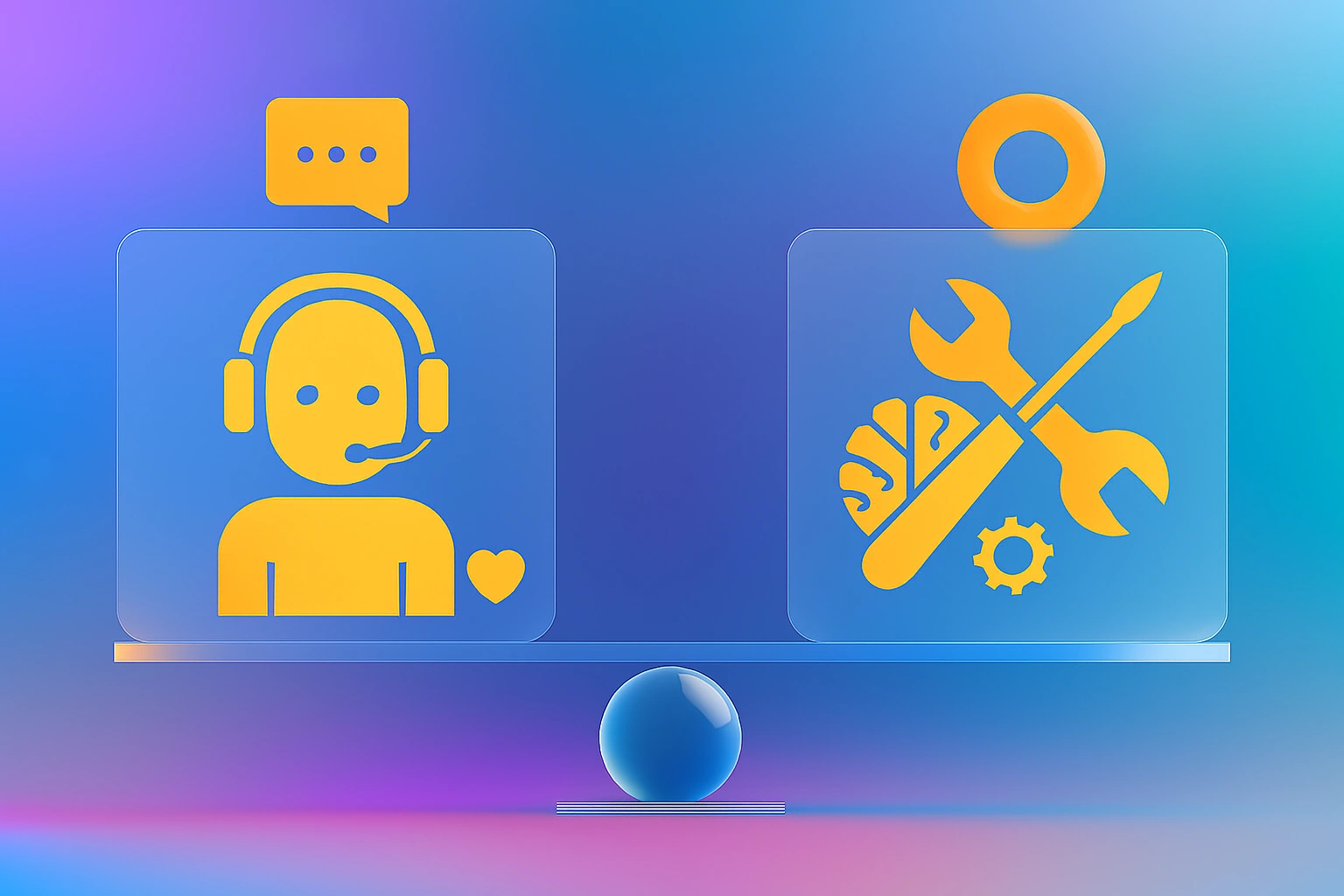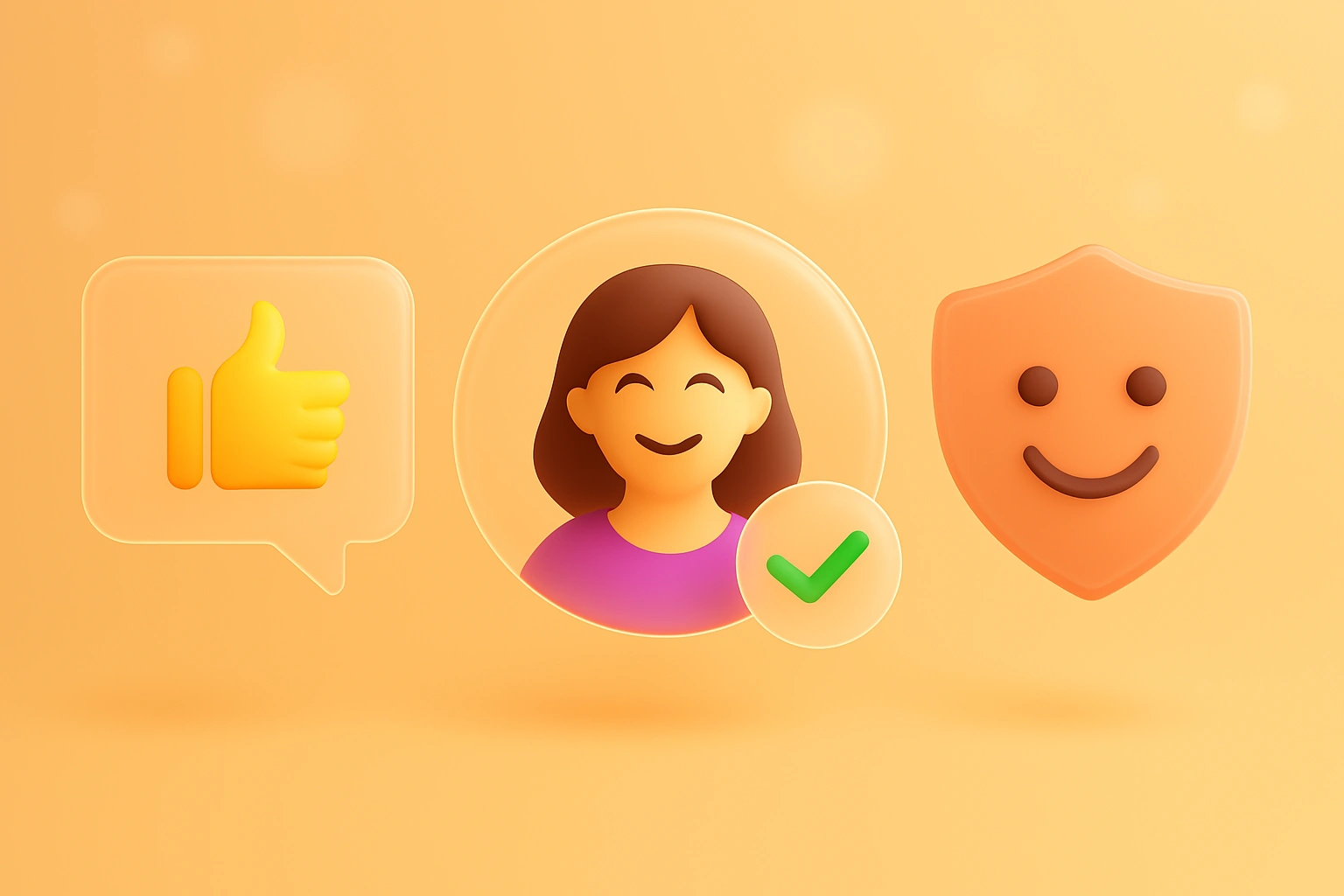What is Customer Happiness + 10 Ways to Improve It
- July 21, 2021
- 16 mins read
- Listen

Let’s discuss a scenario first! A customer gets frustrated after a poor experience and leaves your business. Meanwhile, there are competitors in the market who are trying hard to get the attention of customers and they have already mastered the art of making their customers feel important and valued. The harsh reality is that your dissatisfied customer does not just walk away to one of your other competitors but also often shares his/her grievances, impacting your reputation and bottom line.
Customer happiness is one of the key elements that contribute to business growth. A satisfied customer often becomes the driving force behind consistent revenue, through his good referrals and word-of-mouth marketing power. Studies show that retaining an existing customer costs five times less than acquiring a new one, highlighting the value of nurturing your current customer base. So, it’s never too late to prioritize your clients’ happiness, because it’s more powerful than even the most compelling marketing campaigns.
However, creating genuine customer happiness takes more than delivering a great product or service. It requires empathy, proactive problem-solving, and a strong customer-first mindset. In this blog, we will discuss more about:
- The concept of customer happiness
- Its importance
- Explore 10 actionable strategies to improve it
- How you can measure customer happiness for your brand
What is Customer Happiness?
Customer happiness is the feeling that comes from your customers having their needs met regularly, at the right time, and in the right way.
It is the level of loyalty and satisfaction that your customers experience after engaging with your product, services, or team. Happy customers stay loyal to your brand for a long time. Customer happiness and loyalty are deeply interconnected—when customers trust your brand, they not only stick around but also become enthusiastic advocates, recommending your business to friends and colleagues.
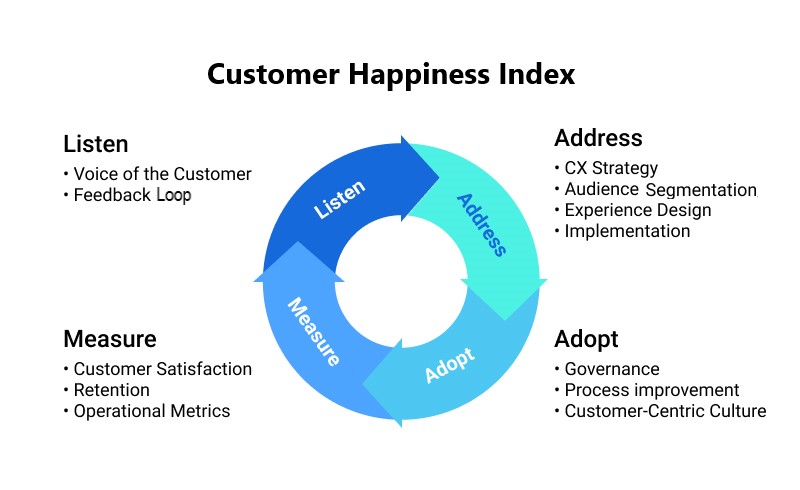
Customer happiness index
Who is a Happy Customer?
A happy customer is the one who is a repeat customer of your business.
Happy customers do not abandon you when you make mistakes; they give you a chance for improvement. They care for you just the way you care for them. Prioritizing customer happiness is an excellent way to understand whether your business is growing in the right direction or not.
While not every happy customer may become loyal, every loyal customer is undoubtedly happy. A happy and loyal customer evolves into a powerful advocate for your business.
Customer Happiness Vs Customer Satisfaction
Customer happiness and customer satisfaction are related concepts, but they capture different aspects of the customer experience.
Customer happiness is like a big picture that includes all the experiences a customer has with a business. It’s about how they feel emotionally and mentally about the company. Happy customers not only feel content with what they bought but also really like the brand.
Customer satisfaction is like a report card that asks, “How much did you like our service or product today?” It measures how much a customer’s expectations are met by what a company offers. It’s usually checked through surveys or ratings.
Satisfaction is just one piece of the puzzle when it comes to achieving customer happiness. While they are distinct concepts, both satisfaction and happiness play a crucial role in fostering customer loyalty to a brand.
The Importance of Customer Happiness
Many businesses prioritize attracting new customers, and while this is important, the true key to long-term success lies in keeping existing customers happy. Achieving this requires careful attention to various aspects of your business and continuously refining them to meet and exceed customer expectations. Here are the key reasons why keeping customers happy is so important.
-
Customer Happiness Improves Loyalty
Your happy customers love your brand and are more likely to stick around. If you make them feel important through your products and services, gradually they start trusting the brand and return for repeat businesses. Various loyalty programs, personalized experiences, and excellent service are key to ensuring customers stay engaged and loyal.
-
Enhanced Brand Reputation
When you consistently deliver great services to your customers it not only makes them happy but also enhances brand reputation. Enhanced brand image brings new customers through word-of-mouth referrals, helps to get partnerships and investors.
-
Reduced Customer Churn
When customers experience something bad, chances are high that they leave and replace your company with any of your competitors. By focusing on happiness, businesses can identify pain points early, resolve issues proactively, and retain their customer base.
-
Delighted Customers Spend More
Research shows that satisfied customers are more likely to make additional purchases. By hiring top-tier sales representatives and providing them with excellent training, businesses can boost customer spending and maximize profits.
-
Boosts Word-of-Mouth Marketing
Satisfied customers are your best brand ambassadors. When they are happy, they share their positive experiences with friends, family, and even on social media platforms, driving organic growth. This kind of authentic endorsement is precious in today’s competitive market.

The Importance of Customer Happiness
How to Improve Customer Happiness: 10 Innovative Ways
Delighting customers has been a core focus of commerce since the dawn of competition. It’s a challenge that requires constant reinvention, as customer needs and expectations evolve based on circumstances and the products or services offered. Here, we’ve outlined some of the most effective strategies to boost customer satisfaction and increase the number of happy customers.
1. Respond to Customer Concerns Faster
Delays in response time is one of the leading causes of customer frustration, often resulting in negative service experiences. Unhappy customers are more likely to share their dissatisfaction to others even on social media channels that can harm your brand image.
To prevent this, businesses should prioritize swift issue resolution through faster responses and aim to exceed customer expectations. According to Salesforce Research, 89% of consumers are more inclined to make repeat purchases following a positive customer service experience.
Live chat solutions and chatbots are two important platforms that help companies to offer real-time assistance to customers. Live chat enables businesses to offer real-time assistance to customers on web and other communication channels. Chatbots allow brands to automate many of their operations including customer service 24/7 and when all of your support agents are busy in other important tasks.
REVE Chat is one such a great AI powered customer support platform that gets seamlessly integrated with your website, mobile app and other social media platforms like Facebook, Instagram, Telegram, Viber and WhatsApp. Your agents can proactively engage with web visitors in real-time and offer personalized services. REVE’s multilingual chatbot enables businesses to offer automated customer service round the clock in their preferred languages.
REVE Chat offers a handful of advanced features to help businesses offer best in class service to their customers. SIGN UP to know more about it.
2. Offer Real-Time Assistance to Your Customers
A highly effective way to enhance customer happiness is by offering instant assistance and minimizing wait times. Implementing customer engagement tools enables businesses to connect with customers quickly, ensuring they don’t face prolonged delays.
Features like voice and video calls empower customer representatives to respond promptly, diagnose issues faster, and deliver efficient solutions. Additionally, co-browsing solutions allow support agents to collaborate with customers in real-time by sharing their browser, providing hands-on assistance with complex issues. These tools create seamless, responsive customer experiences.
How real-time help is useful?
- Customer engagement tools help to identify the issue faster by collecting the information and providing faster solutions.
- Agents can diagnose the problems in the first contact by directly interacting with customers through live chat. It improves FCR and reduces multiple touchpoints.
- Video chat enables friendly personalized conversations that build trust and credibility in customers.
- Through real-time assistance, you can guide customers across all stages starting from awareness, acquisition, engagement, and retention. It enables customers to make quick decisions.
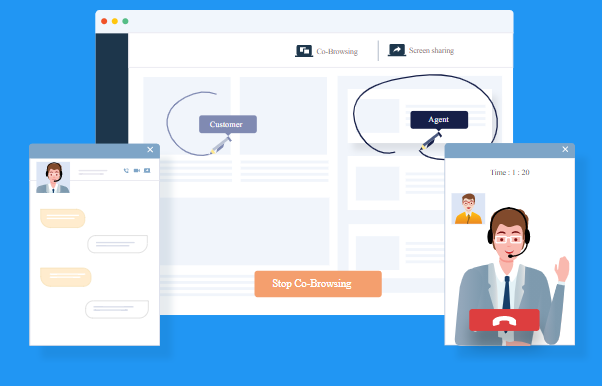
Co-Browsing
3. Deliver a Consistent Experience across all Channels
Customers expect consistent and personalized interactions regardless of the channel they use to connect with a brand. When their experience is inconsistent, and they get to see different communication on different platforms, frustration builds, often leading them to switch to competitors. In simple terms, this means brands need to “be where their customers are.”
Adopting an omnichannel approach allows businesses to unify conversations across platforms like websites, social media platforms, mobile apps, and emails ensuring a smooth and cohesive customer experience. So, choose one such customer engagement tool that seamlessly integrates with all the communication channels and your support agents can handle all the interactions from a single point.
How can businesses delight customers by going omnichannel?
- Identify your customers’ preferred channels and maintain 24/7 availability on those platforms to minimize response times.
- Consolidate all customer interactions onto a single platform to deliver a seamless and unified experience.
- Use tools like live chat, chatbots, visual aids, and self-service options to provide effective resolutions during the first interaction.
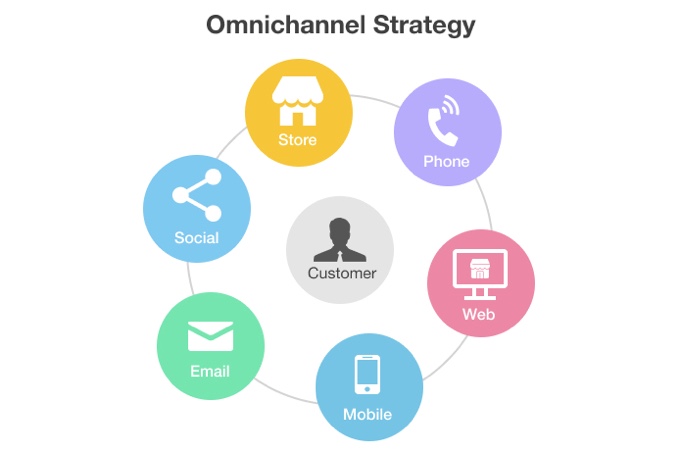
Omnichannel Approach for Customer Happiness
4. Offer 24/7 Customer Service through Chatbots
One of the key reasons why the chatbot is becoming incredibly popular is its capability to deliver instant and accurate responses to customers. You can easily integrate chatbots across all customer channels including websites, mobile apps, and social media platforms.
Equipped with advanced technologies like AI (Artificial Intelligence) and NLP (Natural Language Processing), the bot can easily understand customer queries and offer effective solutions to their problems. However, there might be instances when the bot is not able to identify the user intent in the request and makes a human handover.
How can bots make customers happy and satisfied?
- Bots can use customer data to provide personalized recommendations, responses, and solutions.
- Bots can provide immediate answers to frequently asked questions and help with basic queries.
- Bots offer 24/7 assistance, ensuring customers can get help whenever they need it.
- Bots can proactively reach out to customers based on their browsing behavior, like reminding them of abandoned carts etc.
- Bots can seamlessly escalate complex issues to human agents for better assistance.
5. Appreciate Your Customers’ Feedback
Businesses that prioritize their customers and genuinely value their feedback create deep connections with them, fostering lasting loyalty. When customers feel heard and appreciated, chances are high that they stick with your brand for a long time. Feedback serves as a valuable tool to align customer expectations with business offerings, providing crucial insights.
Encouraging feedback throughout the customer journey helps you understand their true feelings about their experience. Acknowledging their inputs, even in simple ways, can inspire repeat business and strengthen customer relationships.
How to gather customer feedback?
- Use online surveys or polls to gather specific insights from customers.
- Place easy-to-find feedback forms on your website, allowing customers to provide inputs.
- Monitor your social media channels for mentions, comments, and reviews.
- Use Net Promoter Score (NPS) surveys to measure customer loyalty and ask customers how likely they are to recommend your business to others.
6. Reward Your Customers
Rewarding loyal customers should be an integral part of your loyalty programs as they impact customer happiness directly. The happy customers are usually the frequent buyers and certainly, they deserve some rewards from you. Some ideas for rewards are early access, sending invites for special events, and surprising customers with unadvertised discounts.
How can loyalty programs increase consumer happiness?
- Loyalty programs can deepen the emotional bond between customers and brands.
- 59.5% of consumers would like to join a customer loyalty program of a brand to which they are already loyal.
- Loyal and satisfied customers look for both respect and personalized services. When they get what they want, they provide valuable feedback.
- You can include points for referrals as one of the key incentives in your loyalty program.
- By offering rewards for future purchases, loyalty programs motivate customers to return for more.
7. Create a Customer Community
Many times, customers enjoy being part of a community or group. Building communities enhances customer satisfaction by creating a positive atmosphere and strengthening your brand image. These communities can serve as valuable resources for sharing information about products and services. When businesses create spaces for customers to interact with each other, it adds extra value to their experiences, both before and after a purchase. Customers often trust the opinions of fellow customers, especially when making purchasing decisions.
Here’s one example to look into: Southwest Airlines has created an online community where customers can share stories, exchange insights, and draw inspiration from fellow members related to travel and tourism. The discussion forum is organized around common topics, such as boarding, check-in, international travel, and the rewards program, making it easy for users to find relevant information.

South-West Airlines Community
8. Offer Personalized Customer Experience
80% of customers are more likely to purchase a product or service from a brand that provides personalized experiences.
Customers expect business interactions to be customized to their needs and preferences. Hence, businesses need to understand customer behavior and tailor messaging accordingly. Customer engagement tools offer detailed customer information like their past interactions, browsing behavior, buying patterns, geographical details, etc to understand their needs and preferences and based on such info you can easily offer personalized assistance.
How can you offer personalized experiences?
- Divide customers into segments to tailor your offerings to each group.
- Use customer data to suggest products or services based on their past purchases.
- Address customers by their name over calls, live chats, or emails.
- Create loyalty programs that reward customers based on their purchase patterns.
- Use customer data to send personalized marketing campaigns, such as special birthday offers.
9. Follow the Right Communication Etiquette
Every business should set basic ground rules on how to communicate with their customers. It helps to offer best in class customer service leading to happiness and satisfaction. In order to increase your client happiness index, you need to train and educate your employees on how to interact & communicate with customers with professionalism and empathy.
Here are some tips for you!
- Always use courteous phrases like “please,” “thank you,” and “you’re welcome.”
- Avoid lengthy explanations or overly technical terms. Keep your messages straightforward and easy to understand.
- Try to listen actively to your customers without undivided attention. It helps to identify what exactly your customers want, their opinions, feedback, etc.
- A sincere thank you goes a long way. Train your customer support team to offer gratitude at the end of the conversation as a part of customer service etiquette.
- You should always provide authentic information about your product or services to avoid future confusion. Make sure that you don’t make fake commitments and set customer expectations that you cannot fulfill.
10.Understand the Power of Thank You and I’m Sorry
Improving customer happiness often depends on how well your brand acknowledge and address customer emotions. Prioritizing the simple yet powerful phrases “Thank you” and “I’m sorry” can make a significant impact. A simple “Thank you” shows gratitude and appreciation, while “I’m sorry” conveys empathy and accountability, both of which strengthen customer relationships.
Here are some tips for you!
- Regularly thank customers for their business, whether through personalized emails, loyalty rewards, or in conversations.
- Send “thank you” messages for specific occasions like anniversaries, birthdays, or significant purchase milestones.
- Always thank customers for sharing their thoughts and feedback, even if they are negative ones.
- In case of any mistakes, offer a genuine apology without shifting blame.
- After apologizing, explain how you will resolve the issue.
Interesting Customer Happiness Quotes
Why do you think some of the most recognized businesses across the world are so obsessed with CSAT or customer satisfaction? Because no business out there can really be in business without a happy customer. Customer satisfaction is one of the cornerstones of an exceptional relationship that is considered true customer loyalty.
We have outlined some of the awesome customer happiness quotes:
- “Your most unhappy customers are your greatest source of learning.” ~ Bill Gates
- “A satisfied customer is one who will continue to buy from you, seldom shop around, refer other customers and in general be a superstar advocate for your business.” ~ Gregory Ciotti
- “Loyal customers, they don’t just come back, they don’t simply recommend you, they insist that their friends do business with you.” ~ Chip Bell
- “Customer service shouldn’t just be a department; it should be the entire company.” ~ Tony Hsieh, CEO of Zappos.
- “The first step in exceeding your customer’s expectations is to know those expectations.” ~ Roy H. Williams, Author & founder of the Wizard Academy Institute.
- “The customer’s perception is your reality.” ~ Kate Zabriskie
How to Measure Customer Happiness?
Measuring customer happiness is essential for every business. It offers valuable insights into what’s working well and highlights areas for improvement. By understanding customer concerns and addressing them effectively, you can offer better services making them happy and loyal. Here are some effective methods to understand and measure how happy your customers are:
1. Customer Satisfaction Score (CSAT)
It is a survey metric that asks basic questions to customers i.e. “How would you rate your satisfaction with our product or service?” across different channels such as live chat, email, etc.
2. Net Promoter Score (NPS)
NPS measures the overall customer experience with the help of several key questions such as “How likely would you refer the brand to others?”. It has an index on a scale from 1 to 10.
3. Customer Effort Score (CES)
It measures the ease of interacting with your business for a customer. You can design the survey questions with queries like “How easy was it to resolve your issue today?”. It has a scale to rate from “Very Difficult” to “Very Easy.”
4. Churn Rate Analysis
It measures the rate at which customers stop doing business with you. Here you can calculate the churn rate by dividing the number of customers lost by the total customers over a period. Such surveys help companies to understand the reasons why customers are leaving.
Wrapping Up!
Customers are the heart of any business, and through your great services, you need to ensure that they become enthusiastic promoters rather than passive observers. Crafting a thoughtful strategy that uses digital tools, and advanced processes can go a long way in meeting and exceeding customer expectations.
To achieve lasting success, businesses must prioritize customer happiness before everything else. By aligning your brand messaging with what customers truly value, you can create a loyal base of delighted customers and strengthen relationships that last a lifetime.
Frequently Asked Questions
Happy customers are more likely to become loyal brand ambassadors and recommend your brand to others. It also helps reduce churn, improves brand reputation, and creates a long-lasting relationship.
When your employees are satisfied in their jobs, they become more engaged, motivated, and likely to provide excellent service, directly impacting customer happiness and loyalty.
customer feedback helps businesses identify pain points and address them for continuous improvement. when customers see that their opinions matter and the company is actively working to enhance their experience, they feel valued. This not only increases their happiness but also strengthens their loyalty to the brand.
Excellent customer service, personalized experiences, prompt responses, transparent communication, high-quality products/services, and good customer support rep etiquette are some of the key drivers of customer happiness.
Yes, technologies like AI chatbots, live chat tools, CRM systems, and feedback analytics platforms can help businesses to streamline support, offer personalized experiences, and resolve issues efficiently, leading to happier customers.


